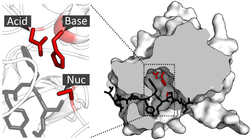Active site
Active Site[edit]
The active site of an enzyme is the region where substrate molecules bind and undergo a chemical reaction. The active site is typically a small pocket or groove on the surface of the enzyme, formed by the three-dimensional arrangement of amino acids. This site is crucial for the enzyme's catalytic activity and specificity.
Structure and Function[edit]
The active site is composed of residues that create a specific environment for the substrate. These residues can participate directly in the chemical transformation of the substrate or help position the substrate correctly. The active site is often highly specific to the substrate, a concept known as the lock and key model.

Induced Fit Model[edit]
The induced fit model suggests that the active site is flexible and can change shape to better fit the substrate upon binding. This model accounts for the dynamic nature of enzyme-substrate interactions.

Catalytic Mechanisms[edit]
Enzymes can employ various mechanisms to catalyze reactions, including:
- Acid-base catalysis: Involves the transfer of protons.
- Covalent catalysis: Involves the formation of a transient covalent bond between the enzyme and the substrate.
- Metal ion catalysis: Utilizes metal ions to stabilize charged intermediates.
- Proximity and orientation effects: Increases the effective concentration of substrates and aligns them for reaction.
Factors Affecting Active Site Function[edit]
Several factors can influence the activity of the active site, including:
- pH and temperature: These can affect the ionization state of the active site residues and the overall enzyme structure.
- Inhibitors: Molecules that can bind to the active site or elsewhere on the enzyme to reduce its activity.
- Cofactors and coenzymes: Non-protein molecules that assist in the catalytic activity of the enzyme.
Examples of Active Sites[edit]
Catalytic Triad[edit]
A common feature in many proteases is the catalytic triad, which consists of three amino acids that work together to perform catalysis. An example is the triad found in TEV protease.

Redox Reactions[edit]
Enzymes like glutathione reductase use active sites to facilitate redox reactions, involving the transfer of electrons.

Related Pages[edit]
Gallery[edit]
-
Structure of an enzyme showing the active site.
-
Illustration of enzyme inhibition.
-
Hydrogen bonding in water, relevant to enzyme interactions.
-
Dipole-dipole interactions in enzyme-substrate binding.
-
Hydrophobic interactions in protein structure.
-
Mechanism of peptide bond cleavage in _-chymotrypsin.
-
Redox states of FAD, a cofactor in enzymatic reactions.
-
Active_site
-
Active_site
-
Active_site
-
Active_site
-
Active_site
-
Active_site
-
Active_site
-
Active_site
-
Active_site
-
Active_site
-
Active_site
-
Active_site
Ad. Transform your life with W8MD's Budget GLP-1 injections from $75


W8MD offers a medical weight loss program to lose weight in Philadelphia. Our physician-supervised medical weight loss provides:
- Weight loss injections in NYC (generic and brand names):
- Zepbound / Mounjaro, Wegovy / Ozempic, Saxenda
- Most insurances accepted or discounted self-pay rates. We will obtain insurance prior authorizations if needed.
- Generic GLP1 weight loss injections from $75 for the starting dose.
- Also offer prescription weight loss medications including Phentermine, Qsymia, Diethylpropion, Contrave etc.
NYC weight loss doctor appointmentsNYC weight loss doctor appointments
Start your NYC weight loss journey today at our NYC medical weight loss and Philadelphia medical weight loss clinics.
- Call 718-946-5500 to lose weight in NYC or for medical weight loss in Philadelphia 215-676-2334.
- Tags:NYC medical weight loss, Philadelphia lose weight Zepbound NYC, Budget GLP1 weight loss injections, Wegovy Philadelphia, Wegovy NYC, Philadelphia medical weight loss, Brookly weight loss and Wegovy NYC
|
WikiMD's Wellness Encyclopedia |
| Let Food Be Thy Medicine Medicine Thy Food - Hippocrates |
Medical Disclaimer: WikiMD is not a substitute for professional medical advice. The information on WikiMD is provided as an information resource only, may be incorrect, outdated or misleading, and is not to be used or relied on for any diagnostic or treatment purposes. Please consult your health care provider before making any healthcare decisions or for guidance about a specific medical condition. WikiMD expressly disclaims responsibility, and shall have no liability, for any damages, loss, injury, or liability whatsoever suffered as a result of your reliance on the information contained in this site. By visiting this site you agree to the foregoing terms and conditions, which may from time to time be changed or supplemented by WikiMD. If you do not agree to the foregoing terms and conditions, you should not enter or use this site. See full disclaimer.
Credits:Most images are courtesy of Wikimedia commons, and templates, categories Wikipedia, licensed under CC BY SA or similar.
Translate this page: - East Asian
中文,
日本,
한국어,
South Asian
हिन्दी,
தமிழ்,
తెలుగు,
Urdu,
ಕನ್ನಡ,
Southeast Asian
Indonesian,
Vietnamese,
Thai,
မြန်မာဘာသာ,
বাংলা
European
español,
Deutsch,
français,
Greek,
português do Brasil,
polski,
română,
русский,
Nederlands,
norsk,
svenska,
suomi,
Italian
Middle Eastern & African
عربى,
Turkish,
Persian,
Hebrew,
Afrikaans,
isiZulu,
Kiswahili,
Other
Bulgarian,
Hungarian,
Czech,
Swedish,
മലയാളം,
मराठी,
ਪੰਜਾਬੀ,
ગુજરાતી,
Portuguese,
Ukrainian











